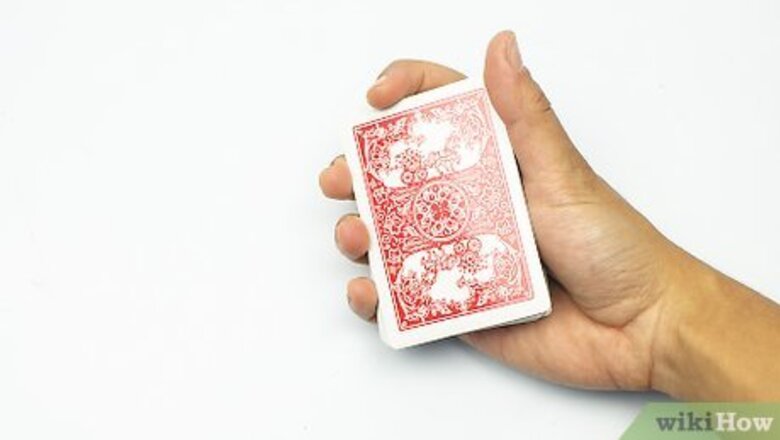
views
Doing the Charlier Cut
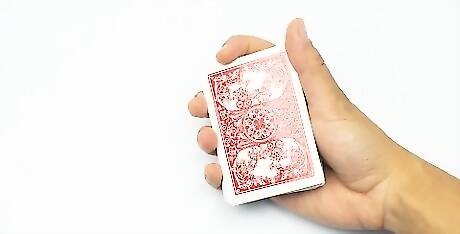
Hold the deck in your hand with your palm up. Let the deck rest cupped in your palm and the lower part of your fingers. The deck should be face-down in your hand and stay face-down through the whole cut. Grab the deck with the dealer's grip, which means the length of your thumb is on one long side. Place 3 fingers on the other long side and your index finger on top. At this point, the deck should be flat against your palm.
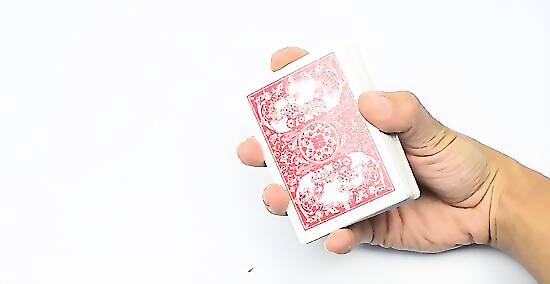
Lift the cards up into a claw grip. Bring your pinkie to the end of the cards first, then use it to lift the deck up. Move the deck up so that it's not on your palm anymore. Balance it between your fingers; the cards should be against your finger pads, not gripped in the very tips. Keep the thumb on one long side, 2 fingers across from that, and 1 finger on each end.
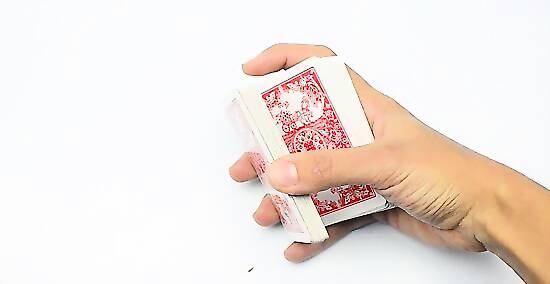
Use your index finger to pull some of the cards into your hand. Your index finger should be at the top of the deck. Slide your finger down the edge of the cards until you get to a spot where you want to cut them, and then use the tip of your finger to pull those cards down into your palm. If this move is giving you difficulty, try just releasing a little pressure from your pinkie and index finger and then allowing some of the cards to drop down into your palm.
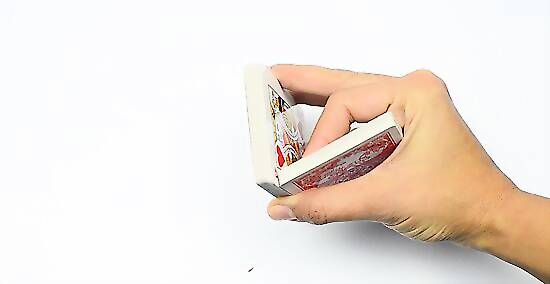
Push the cards on the bottom up away from the cards in your fingertips. Tuck your index finger under the bottom cards on the long side away from your thumb. Push on that edge from the bottom of the card to lever the cards out from below the top set of cards. As you push the cards up, the long edge of the cards underneath will go across the face side of the cards above. Brace the other edge of those cards against the dip between your index finger and your thumb as you wait to catch the cards with your upper thumb.
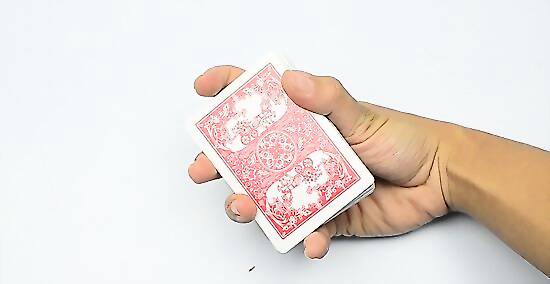
Let the bottom cards slide on top of the top cards. As the long edge of the lower cards reaches the other long edge of the top cards, you've cleared space for the top cards to fall gently into your fingers below. Use your thumb to guide the bottom cards in place on top of the cards that just fell below. If you can, keep hold of the top set of cards with the tip of your thumb until the bottom cards are ready to go up and over. If your hands are too small, move your thumb off the cards partway through and balance the upper cards on the lower cards as you do. If you find your hands are still too small, try buying bridge cards, which are slightly smaller than poker cards.
Performing a One-Handed Revolution
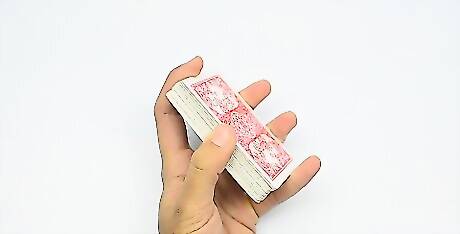
Begin with the dealer's grip. Hold the deck up against your palm with your fingers on the side. Your thumb should extend along one long side with 3 fingers on the other long side. Put your index finger on the top edge of the deck to hold it in place. This is the standard grip so many types of cuts begin here.
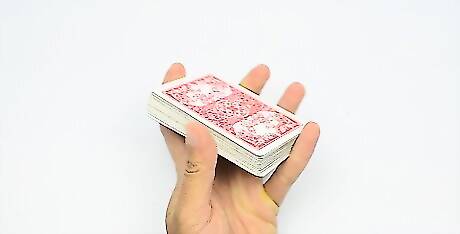
Move to the elevated mechanic grip. This grip is similar to the claw grip. Move your pinkie around to the end of the cards so you can elevate them to your fingertips. Place all 4 fingers on one long side while your thumb is on the other side. The cards should be touching your finger pads not the very tips of your fingers. Some people stay in a claw grip for this trick, where you have an index finger on one end and your pinkie on the other.
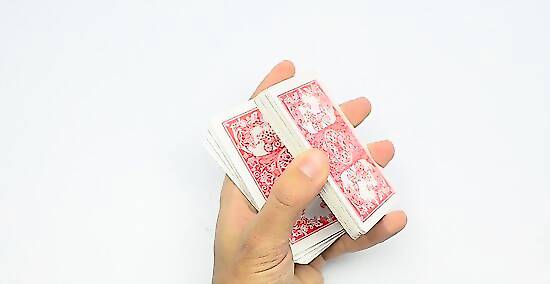
Let part of the deck drop down into your hand. Lessen the tension on the bottom of the deck so part of it falls below. You can also use your thumb to separate out some of the cards by ruffling along the edge of the deck and pulling some of the bottom cards down toward your palm.
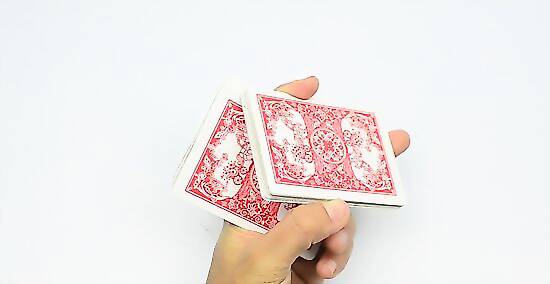
Grasp the top stack with your index finger and thumb as you push your ring finger underneath. Drop your pinkie, ring finger, and middle finger off the top stack of cards. With just your index finger and thumb holding the top stack, you should be able to swivel it out away from your hand a little bit. Slide your ring finger under this stack along the face of the card. As you do, the bottom stack of cards will come up a little and you can slide your ring finger between the 2 stacks. Both stacks should still be face down in your hand. The stacks should basically be on top of each other at the top but swing out to form an "A" at the bottom. Your finger is separating the 2 long, inner edges of the cards.

Push the stack out with your thumb, ring finger, and index finger. You should have the top stack held on 2 sides, the thumb and ringer finger (facing the wrong way) on one long side and the index finger on the other long side. Swing the top stack outward away from your hand.
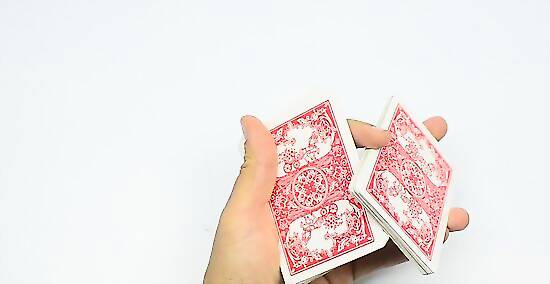
Let go of the top cards with your thumb as you catch them with your middle finger. When you let go of the cards, they will automatically spring out a little. Use your middle finger to brace them on the outside. Start straightening out your fingers as you do. You should have the cards braced in your index finger, your middle finger, and the back side of your ring finger.

Curl your index finger in as you bring the bottom cards up. As you straighten out your middle finger, the top cards will extend out and twist around a bit. Curl your index finger in while still gripping the cards. Your index finger will come in between the 2 sets of cards along the inner edges, which will bring the bottom cards up toward your thumb and twist the top cards around so that you can bring the outer edge underneath the other partial deck. Your index finger has always been on the outer edge of the deck of cards. As you curl it inward, you bring that edge to the inside.
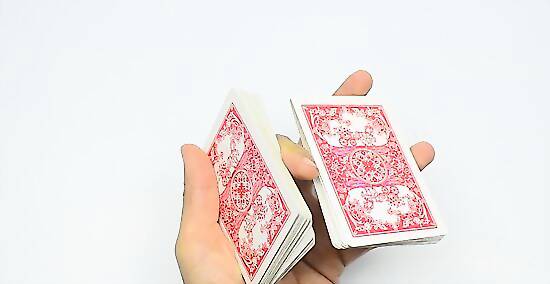
Let the top cards fall under the bottom cards and pull your finger out. The top cards should just slide underneath the bottom cards with the help of gravity. As they do, pull your index finger out and settle the cards in place.
Doing a Scissor Cut
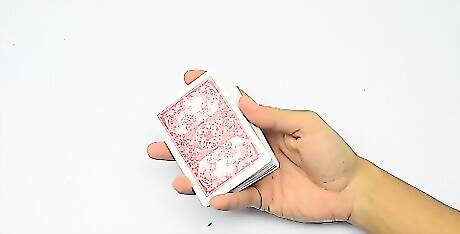
Move the cards into a straddle grip. Hold the card's in the basic dealer's grip with your thumb along the long side, 3 fingers on the other side, and your index finger on top; the cards should be flat against your palm. Release your thumb as you move your pinkie to the other end. Make some space between your palm and the cards by lifting them up slightly. All it will take to lift up the cards is to tilt your fingers out a bit while holding on tight to the deck.
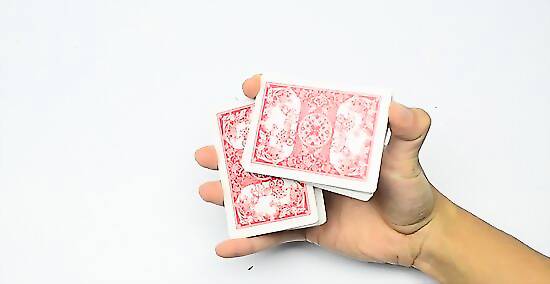
Grab some of the cards on top of the deck with your thumb and index finger. Tilt the cards slightly toward your thumb. Place the side of your thumb on the bottom of the deck at the closest corner. Use the corner of your thumb to lift off a section of cards that you grasp between your index finger at the top and your thumb at the bottom. At this point, you should have one section of cards on top tilted to your thumb and the other section of cards on the bottom tilted away from your thumb. Your index finger should be on both sets of cards. Apply pressure on the bottom section of cards with your other fingers.
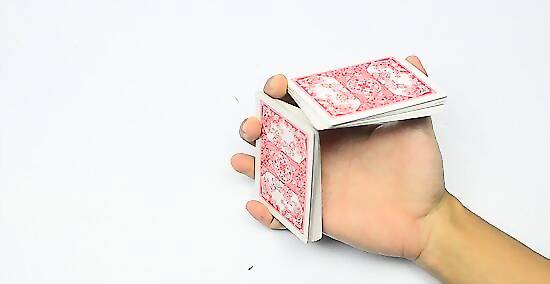
Pull the top section toward your thumb as you push the bottom section out. You should have the top section in your index finger and thumb. Keep turning them toward your thumb, moving them away from the bottom section. As you do, you should still have your index finger on the bottom section, which you should push lightly toward your other fingers. Make sure to keep a good grip on the bottom deck with your other fingers.
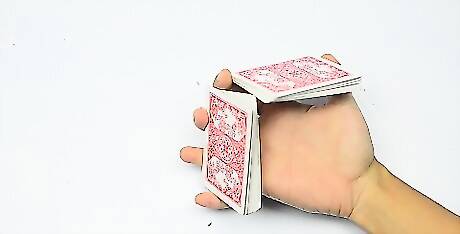
Create space between the 2 short edges with your index finger. As you bring the top deck around, you want to clear the top edge of the bottom deck completely. Curl your index finger slightly down and bring it between the 2 short edges of the separate decks. Make sure you're still holding on to both decks with your index finger. At this point, you should have part of the deck between your thumb and index finger (one on each of the short ends) and part of the deck between your index finger and the rest of your fingers. They should be stretched out long ways across your hand.
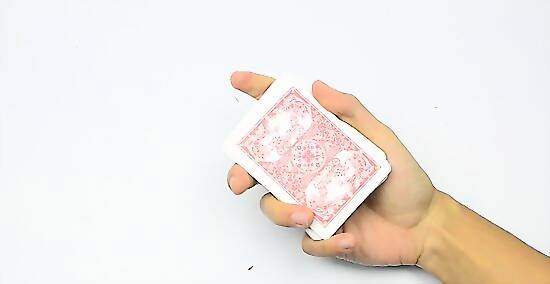
Slide the thumb stack underneath the other stack. Twist your index finger and thumb around toward the other stack, going underneath it. Slide the cards in place and settle them into your hand. You're going to put it in place the same direction you took it off the deck. However, instead of going above the other deck, you'll slide below it.


















Comments
0 comment